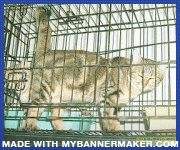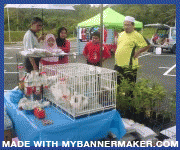Topics:
Gestation: the Most Confusing StageThe reason I say this is because it is very hard to tell if your doe is pregnant. There is even an event that can cause a doe to act like she is going to have babies up to the point of trying to build a nest, but no babies appear. I'll explain everything. How Long Gestation LastsHave you ever heard the saying "[It multiplies] like a rabbit"? It's true. A rabbit's gestation lasts for only a month. Yes, you heard me. Around four weeks. And the time flies by. The most important thing you can do while breeding is to keep records. You need to record when you bred the rabbits, keep track of time until 28 days have gone by, and then put in a nest box and bedding (inside the nest box, that is). If the rabbit doesn't have babies in 36 days, call the vet, because the babies can't stay inside the doe. It will make her very, very sick and die. A typical wooden nest box. Telling if She's PregnantThis is just about the hardest part of the gestation issue. Something that will give you a good hint about if she's going to have babies soon is if she starts carrying hay around in her mouth trying to make a nest out of it. You should, however, try to figure out if she's pregnant before that. People will tell you many ways to see if a rabbit's pregnant or not, but only one way really works. Palpation. Palpation is an art of the skilled. My mother can't even do it. (I can, though.) I will explain palpation in a minute, but first, I want to warn you about some really corny pregnancy tests. Hoax Pregnancy TestsThe first corny test I'll explain is called check mating. This is when you put in the doe with the buck again 2 weeks after the first mating. This is what is supposed to happen: if the doe is pregnant from the first mating, she will refuse the buck. If she is not, she will take him. This can be very bad, because the doe can accept the buck even when she is pregnant, and then she would have two litters that were two different ages inside of her, and since they would both be born at the same time, one litter would be too old and die, and the other would be too young and die. Also, the doe could refuse the buck even if she wasn't pregnant. The second way that doesn't really work is weighing your rabbit just to see if it is pregnant. It is very good to weigh her solely for records, but it just doesn't do the trick when you are trying to see if she is pregnant or not. I've had does that gained weight while not pregnant after being mated, and pregnant does that actually lost an ounce or two. Most just stay the same weight throughout most of the gestation period. You also can't tell if their stomach gets bigger, because, to tell the truth, it doesn't. PalpationPalpation is the best way of telling if a doe is pregnant or not. This is the method of feeling her abdomen to see if there are any babies inside. For beginners, this method is most easily done at two weeks after breeding or more. I will explain how it's done in the following list, with assistants of pictures.
Birth and Development |
POKOK MAJAPAHIT @ Qudrifarm
5 years ago















No comments:
Post a Comment